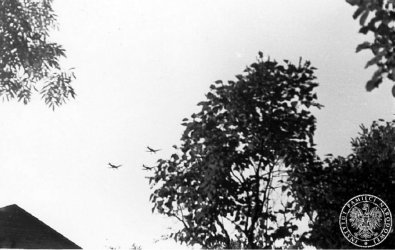
A flight of three German Ju-87 going to bomb insurgent positions in Warsaw
(archives of IPN, BU 1133, neg.3, kl.10A, author: E. Widlicki, around August 8th, 1944);
Shootdowns of German airplanes during the Warsaw Uprising
Armed struggle of the Polish Underground Army against Germans during the Warsaw Uprising revealed huge disproportion in armaments, not to mention the fact that not only in the moment of starting the battle the Home Army (AK) was underarmed in basic small arms for the infantry soldiers, but also German Army had heavy artillery, armor (including also an armored train), an armed cutter and aviation.
German airplanes turned out to be a particularly efficient weapon in combating Polish uprising forces, civil dwellers, and destroying buildings (transformed into defensive redoubt) of the Polish capital, because of their practical impunity in the sky above Warsaw. It was caused by the lack of power of Polish anti-aircraft guns as well as by the order of the Polish command forbidding to use so scarce ammunition for ant-aircraft purposes. Despite all this, Poles were able to shoot down two German airplanes during the Warsaw Uprising. One was shot down directly above Warsaw, while the other during the battle of Jaktorow.

A flight of three German Ju-87 going to bomb insurgent positions in Warsaw
(archives of IPN, BU 1133, neg.3, kl.10A, author: E. Widlicki, around August 8th, 1944);
Above the Warsaw
Since August 4th, 1944, German forces which were fighting off the Warsaw Uprising were supported by German aviation. They were mostly the Junkers-87 ("Stuka") D-5. The Ju-87 was a two-man (pilot and rear gunner/radio operator) dive bomber, single-engined all-metal cantilever monoplane. The D-5 variant differed from the earlier variants as it had slightly lengthened wings and two 20-mm cannons mounted in the wings.
Over the Kampinos Forest and in the sky of Jaktorow
Moreover, it had the following manufacturing specifications:
- wingspan - 15 m, length - 11.50 m, height - 3.88 m;
- wing area - 33.68 m2;
- empty weight - 3940 kg, loaded weight - 6580 kg;
- powerplant - 1 x Jumo 211 J-1 engine (1420 hp);
- maximum speed - 400 km/h, diving speed - 650 km/h;
- service ceiling - 7500 m, maximum range - 1530 km;
- armament: 2x 20 mm cannon, 1x 7.92 mm machine gun, bomb payload - 1000 kg.
Although in the second half of 1944 the airplane was already out-of-date, it did excellently in actions above the insurgent city. One may venture to say that out of all the weapons used by German forces, it was the German Ju-87s that inflicted the biggest losses to the insurgent Warsaw - when it comes to both insurgents and civilians as well as to destroying buildings. Moreover, above the Warsaw appeared also German Messerschmitt Bf 109 G-6 fighter planes (a single-seat low wing all-metal aircraft with the following specifications: maximum speed - 690 km/h, service ceiling - 11 500 m, armament: 2x 13 mm machine gun and 1x 30 mm cannon) and Heinkel He 111 H medium bombers (a twin-engine low wing aircraft, 5 crewmen: - pilot, navigator/bombardier and three gunners; maximum speed - 400 km/h, service ceiling - 8390 m, armament - 6x 7.92 mm machine gun and 1x 20 mm cannon, bomb payload - 2500 kg). Over 20 of the latter ones took part, for example, in the low-altitude bombing of fortified areas in Wola and Srodmiescie districts on August 5th.
In the article "Luftwaffe przeciwko powstaniu warszawskiemu" ("Lotnictwo" 10/2009) by Norbert Baczyk we can find a quoted German document "Uzycie 6 Floty Powietrznej w ramach walk o Warszawe od 1.8 do 2.10 1944", in which follows the summary of German air operations against the Warsaw Uprising. In that document we find the following data about the performed combat actions:
- 1408 sorties performed by the Ju-87 of the 1st Air Division, including 711 sorties by the Lieutenant Klussmann's group, consisting of 4 Ju-87 D-5, which stationed at Okecie airport between August 18th and September 19th after having been assigned specially to operations in Warsaw;
- 68 fighter-bomber sorties performed by 1st Squadron, Jagdgeschwader 51 (JG 51 - a Luftwaffe fighter wing), 1st Air Division (Me 109 G-6);
- 130 sorties by the tactical air force of the 4th Air Corps (consisting of 4 bomber regiments equipped with He 111 H airplanes;
- the total of 1580 tons of bombes were dropped on Warsaw.
It has to be stressed that until September 13th, 1944, the Luftwaffe operations in the area of Warsaw were taking place by the passivity of the Soviet aviation, although the front was right in front of the city. It was not until September 10th that Stalin gave permission for American airplanes which were bringing help for Warsaw to land on Soviet territory, and on September 13th he ordered Marshal Rokossovsky by phone to give all possible aid to the insurgents. Since that moment Soviet airplanes began providing air cover of Warsaw and supporting the insurgents with airdrops of supplies.
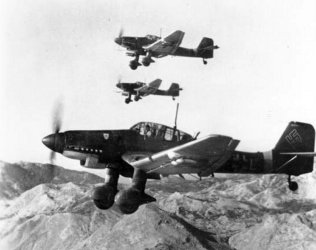
A flight of Ju-87 ("Stuka") bombers in the eastern front;
For Poles fighting in Warsaw the impune and efficient German aviation was a leathal weapon. This is the relation from "Sierpien przez cale zycie" (Warszawa 1994, page 115) by Juliusz Kulesza concerning the bombing at 3 Mlawska street (the Old Town) on August 28th, 1944: "We were talking for a quite long time when, suddenly, a familiar, incoming hum appeared. As always in such moments, somebody cried: - Airman, get cover! - what I've always considered as a nonsense, as it sounded more like a warning for that airman and not as a warning of him. We went down to a basement. Then there was: a short roar of an engine over the heads, a dull knock, a few seconds of silence, and then - an impression of the world coming to an end... A grey darkness, a choking of laranx with a suspension of grainy sand and plaster, something showering on the head, coughs, moans and calls, the atmosphere of panic. And a flash of relief after seeing that the bomb already exploded and I am still alive, subdued immediately by the horror of the words: - We are stranded! - spoken by one of grey silhouettes, more and more looming in the cloud of dust settling down. Only the entrance was buried. There was an intact shop above us, after having got into which, several dozen people, covered entirely in grey and russet coat, clambered through shop-windows onto the street."
On August 23th, 1944, (Wednesday), around noon, Poles managed to shoot down a German Ju-87 D-5 of Lieutenant H. J. Klussmann's group. The machine fell down in the territory occupied by the insurgents, on a building in Hipoteczna street, and then on the street itsef. It is not clearly explained who shot down the enemy aircraft. Now two versions exist. According to the first one, the author of such huge unprecedented success of Polish insurgent forces was Watch-master officer cadet "Motz" Jerzy Ciszewski (born on February 14th, 1916) of "Gozdawa" Battalion, "1806" Squadron.
This is the description of that event by Stanislaw Ozimek ("Stare Miasto 1944", Warszawa 1971, [source:] N. Baczyk "Luftwaffe..."): "In the ruins of the city hall there was a light machine gun position which was suppressing German grenadiers hidden behind the collonade of the Grand Theatre's frontal. The aimer - Officer Cadet "Motz" (Jerzy Ciszewski), ordnanceman (rifleman) "Wieslaw". In the redoubt nearby the barricade Miodowa-Senatorska there was "Rusik I" at the machine gun dismounted from the "Lancaster" which had been shot down over the Old Town. It was repaired in a insurgents' armory, charred with fire, bowed and often jamming. In normal circumstances it would have been scrapped. Now, in the hands of Staff Sergeant "Rusik" from the "Gozdawa" subsection it became a threatening weapon. Four "Stukas" are coming flying over the Old Town at high noon. Sanctified by a ritual, a dance of death over the roofs and ruins begins. And in almost the same time, despite the categorical order to save ammo, from two positions (Sgt. "Rusik" and Officer Cadet "Motz") fell bursts towards the closest nosediving machine. The "Stuka" escaped quickly from the range of "Rusik's" LMG and got into the sight of "Motz".
He picked the LMG of the pod and propped by "Wieslaw" aimed at the front of fuselage, at the engine's radiator, of the growing machine. Trigger. Continuous fire. The machine gun strains at the hand. - Got him! - yells halfconcious "Motz". A wisp of smoke in the back of the fuselage. Pilot tries to straighten out the machine flying towards the roofs. The engine chokes. The aircraft, suddenly leapt up, seems to have stopped in the midair, sways to the sides, loses the balance and hits violently the roof of the several storey high Ludwik Spiess's apartment house in Hipoteczna street. The wings fall off, crushed fuselage falls down into the gully of the street. A column of black smoke, the bodies of pilots thrown away violently at the distance of several dozen meters. Cringed figures, shapeless like bags. They give no sign of life. Spilled fuel fries on the pavement around the plane, creating a burning barrier."
According to the other version, the German Junkers was brought down by 2nd Lieutenant "Irma" Jan Korzybski (born in 1914; of the "Gozdawa" Battalion, "1806" Squadron). Krystyna Golanska (née Janiszewska) of the AK Assault Battalion "Nalecz" says (source: www.powstanie-warszawskie-1944.pl): "On August 23th, 1944, around noon, I was running from my quarters of the 1st Assault Battalion "Nalecz" at 5 Hipoteczna street to the outpost of Captain Piotr of 1806 Squadron embracing the area of: "Dom pod Krolami" [lit. House under Kings], the prison in Danilowiczowska street and the Canoness Sisters Monastery with the whole northern side of pl. Teatralny. I had there many friends (Tadeusz Zawadzki, Miroslaw Tymieniecki, Joanna Rybarska). We were all witnesses of an unusual event. A German bomber (Junkers Ju-87) fell suddenly on the building of "Spiess" company in Hipoteczna street and tumbled down on the street, where it was burning for a long time, giving off a foul reek of burning tires.
There was no doubt that someone hit the pilot, whom we all had seen clearly behind the pane of the low-flying aircraft. - But who - I asked entering the outpost. - Who shot? - Jan Korzybski "Irma" - answered Mirek Tymieniecki "Piotr", adding after a moment: "Maria Zieleniewska's husband". It was then when I learned that "Irma" was the husband of my friend (now Maria Ginter) from Cecylia Plater-Zyberk Gymnasium. That event lifted the morale of insurgents and civilians immediately. The hero's name was on the lips of everyone, and he himself was being tossed enthusiastically into the air. It was the only so incredible case of shooting down a plane with a light machine gun. Unfortunately, three days Jan Korzybski got fatally wounded."
Abovementioned fragment of the German report ("Uzycie 6 Floty Powietrznej w ramach walk o Warszawe od 1.8 do 2.10 1944" [The use of 6th Air Fleet in the fights for Warsaw since August 1st until October 2nd, 1944"]) describing the insurgent anti-aircraft defense confirmed - it needs to be admitted that in quite laconic manner - the loss of one aircraft with crew (source: N. Baczyk "Luftwaffe..."): "The anti-aircraft defense of the insurgents consisted of HMGs and rifles which constituted danger, because the flight had to fly constantly in the area of the positions of those weapons. The loss of one crew and often damages to machines were caused by it."
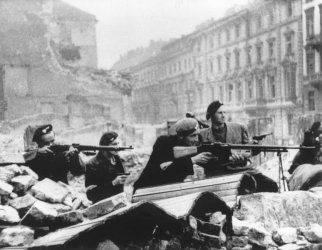
Insurgents on the barricade, a possible anti-aircraft weapon on the right - prewar Polish Browning wz.1928 (light machine gun)
(author: J. Tomaszewski, August 1944);
There are also other, unconfirmed, notices of shooting down German machines, e.g. the case of the first days of the Uprising, when, according to Polish reports, a light reconnaissance aircraft (it could have been a Fieseler 156 Storch). The fact is mentioned by Norbert Baczyk in his article. Similarly, in Wielka Ilustrowana Encyklopedia Powstania Warszawskiego tom 1 one can find a notice of shooting down an other German Ju-87 by soldiers of "Krybar" Group in the area of Powisle neighborhood, precisely over Tamka street. Unfortunately, the editors do not give even the date of that event. These two abovementioned cases has not been fully confirmed (e.g. by German documents) nor positively verified. In my opinion they should not by counted as sure losses of the German side. Perhaps they constituted only some damage done to German machines.
As a part of the counterinsurgent operation "Sternschnuppe" conducted since August 27th, 1944, against the "Kampinos" Home Army Group, German aviation did very intensive (considering the fact that they were fighting against insurgents) air reconnaissance over the Kampinos Forest. On the basis of the reconnaissance, Germans estimated that Polish insurgents are concentrated in the areas: west to Czeczotka, in Sowia Wola, in Fabryczna, in Kiscinne and in Krogulec. However, the largest forces spotted in Wiersze and in the closest vicinity.
written by: Szymon Nowak
The air reconnaissance saw a large number of insurgents around that place, dug fortifications, and a big, white building with radio station antenna in the village itself. It was supposed that the command of insurgents was located there. At 15:45 German aviation in the strength of 8 Ju-87 bombed Wiersze village, as a result of which many buildings were destroyed, including aforementioned white house. Bombs hit also ammo depot, causing a large explosion. On the same day, at 18:20, also Brzozowka village was bombed.
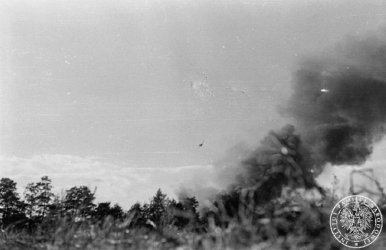
Attack of German Ju-87 ("Stuka") dive bombers on the "Kampinos" Home Army Group's base in Wiersze
(archives of IPN, BU 1133, neg.5, kl. 20A, author: E. Widlicki, Wiersze, September 27th, 1944);
The air raid on Wiersze village caused few losses on the side of the insurgents. According to Marian Podgoreczny ( typescript "Na koniu i pod koniem" [lit. "On the horse and under the horse"]) a few soldiers were killed back then, and 14 were wounded. The operation of German aircrafts is recalled by Corporal Franciszek Kosowicz (source: A. Pilch "Partyzanci trzech puszcz", p. 214, 215 [lit. "The insurgents of three primeval forests"]): "We were in the front-yard of our headquarters. There were a few of us and we were waiting for orders. Horses were bound to palings, under the trees. Suddenly, we saw a few German aircrafts. We were gazing at them with an interest. Then "Dolina" [pseudonym of one of the soldiers] stormed out of the headquarters, looked at the airplanes and yelled: - "Airman" - hide yourself! - We all ran to a garden. In just a few seconds we were already lying with our faces to the ground in shallow ditches. There was also "Dolina" in the ditch next to us. These seconds saved our lives, because the aircraft were already dropping bombs exploding in the area of buildings and our headquarters. All the buildings went to pieces, and so did our horses. Thank God! - we were covered with earth and falling remains of houses and trees, but we survived and got out of the ditches alive, without any serious wounds."
German intelligence reports show the air operation of September 27th, 1944, in the following manner (source: "Powstanie Warszawskie" ["Warsaw Uprising"] by Jerzy Kirchmayer): "Air reconnaissance claimed that the main forces are located in Wiersze village. On the edge of the village - shooting trenches and shooting nests, in the village a conspicuous white house (probably a battle position), a radio station next to it. In Sowia Wola village 200 bandits gathered in groups were spotted; Kiscinne and Krogulec villages manned with bands. The edge of Wiersze-Rostoka forest manned with bands. At 15:45 Ju-87 bombed Wiersze village. Very good effectiveness. The place is burning in many points. An ammo depot exploded. A radio station was hit. A white house caught fire. At 18:20 Brzozowka village was bombed. At 17:20 Ju-52 flew over the Kampinos Forest in a low-reconnaissance mission. Air raid and flight from the south of Beniamowo village ( 6 km to the north-east of Radzymin) - in the rear of Russian forces."
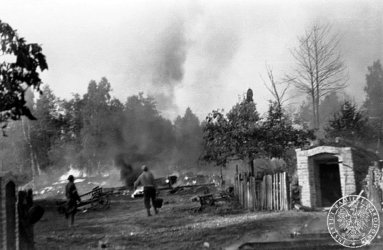
The village of Wiersze is burning after having been bombed by German airplanes
(archives of IPN, BU 1133, neg.5, kl.25A, author: E. Widlicki, Wiersze, September 27th, 1944);
In view of the air attacks on the base of insurgents in Wiersze and the pressure of German battle groups on Polish outposts, the commander of "Kampinos" Group, Major "Okon" A. Kotowski decided to march out and head to the western areas of the Kampinos Forest. There, in forests, in nearby Bieliny village, the columns of insurgents made an all-day stop.
On August 28th, soldiers of "Kampinos" Group saw in the sky a German reconnaissance aircraft, which tried to find the Polish units, however with no success. It was a Focke - Wulf Fw 189 Uhu ("Eagle Owl") commonly called as a "rama" ["frame"]. Before the dusk of the same day, Polish units marched out to travel further, this time heading to the south. The aim of the command was to reach the Swietokrzyskie Mountains. They were marching all night long, and so about 7:00 a.m. of September 29th, 1944, the column arrived to the area of Budy Zosine village, where Major "Okon" ordered a stop.
It was to turn out that the decision had not been beneficial - in front of Polish insurgents there were railway tracks of Warszawa-Skierniewice line. At around 8:00 a.m. An hour later a reconnaissance Fw-189 aircraft learned about the dislocation of Polish insurgents group. At the same hour German subunits from Zyrardow garrison began to man the positions along the railway tracks. Soldiers of the "Kampinos" Group found themselves in a trap. They did not know that units of the German 70th Grenadier Regiment, 73rd Infantry Division were coming from the north, whereas the No. 30 armored train was from the east. At around 10 a.m. Polish rearguard was forced to withdraw from Baranow village.
At around the same time (10:00 a.m.) a German Focke-Wulf Fw 189 Uhu reconnaissance aircraft showed itself again over the Polish positions.
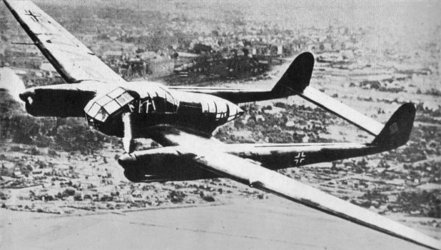
German tactical reconnaissance Focke-Wulf Fw 189 Uhu ("Eagle Owl") aircraft, commonly known as "rama" (frame);
It was a twin-engine monoplane with an unusual twin-boom design, characterized by perfect visibility from the cockpit and low minimal speed, useful in reconnaissance missions. Performance: maximum speed 372 k/h, service ceiling - 7300 m, range - 690 km. The aircraft was powered by two Argus As 410 A-1 engines (465 hp each). It was armed with two 7.92 mm MG 17 machine guns and one 7.92 mm MG 15 machine gun in dorsal position (operated by a observer) and one 7.92 mm MG 15 machine gun in rear cone (operated by a gunner).
In the A-2 variant MG 15s were replaced by twin-barrel 7.92 mm MG 81Z mounted in both gun positions. The aircraft could take up to 200 kg of bombs on board, while the crew consisted of 3 men (pilot, observer, and gunner). Moreover, the machine was equipped with a video camera, a camera and a radio station. General characteristics: wingspan 18,4 m, length 12 m, height 3,07 m, empty weight 2830 kg, loaded weight 3950 kg. The Focke-Wulf 189 was produced since 1939 until 1944, with the total of around 850 machines built.
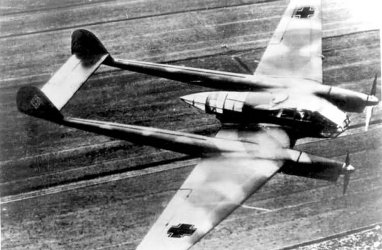
German tactical reconnaissance Fw 189 aircraft;
On September 29th, 1944, over Budy Zosine village, after returning a few times and reducing the ceiling, a German "Rama" (Fw 189) began shooting with its on board weapon at the insurgents crowded in a small area. The bullets of the German machine and low-altitude of its flight caused general destruction and spread panic mainly when it came to insurgent cavalry and horse carts. The German machine enraged the insurgents.
They started to shoot at the enemy plane with all kinds of weapons they had. For instance, Master Corporal "Wierny" Bolesla Mostkowski with a LMG, Second Lt. "Chlebowicz" Andrzej Polonski with a Bren Gun, Watch-Master "Plaz" Czeslaw Juchniewicz (all three of 3rd Squadron; Watch-Master "Plaz" was a deputy commander of 3rd Squadron) was firing at the "rama" with... a TT pistol.
Surprisingly, during one of turnarounds the enemy machine was hit and flames appeared. For a moment it was still flying on its previous path followed by a wisp of smoke, but then it changed its flight's trajectory and after having made a large turn it crashed nearby the railway tracks, 7 km to the west of Grodzisk, as it was later stated in the German report.
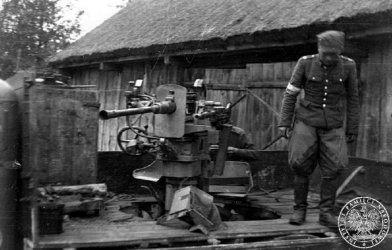
An armament of the Home Army Group "Kampinos" - a 20mm gun coupled with MG-34 machine gun, mounted on a car.
A possible anti-aircraft weapon, unfortunately there is no confirmation on its use against German aircrafts in Jaktorow.
(archives of IPN, BU 1132, neg.4, kl.119, author: L. Gaszewski, Wiersze village, September 21st, 1944);
Marian Podgoreczny "zbik"(of the retinue of the commander of 3rd Squadron, 27th Regiment) recalls in his memoirs: "Na koniu I pod koniem": "We did not manage to dismount yet, when a twin-boom aircraft "Rama" appeared in the sky. The same which had been haunting us in the forest. It came flying quietly, almost unnoticeably and suddenly opened fire from its on-board gun, while flying in low altitude at the moment when we heard the whir of an engine. That one aircraft caused the same turmoil as four tanks nearby Baranow. Our squadron got to a farm with a cherry orchard. We got off the horses and opened chaotic fire at the wings with a black cross. Those calmer ones were selecting unflinchingly incendiary bullets with red percussion caps from an ammunition pouch.
And suddenly... Incredible! All of us went into a frenzy. We were laughing like kids, clapping our hands, tossing caps into the air, waving our rifles. The aircraft went into flames, covered with a black ribbon of smoke and crashed with a whine, exploding near right next to the railway tracks. - It was me who shot it down - yelled Zybul-Cywinski, who were firing with a sub-machine gun. - Don't make me laugh, man - snorted Osa, who was shooting with a LMG. - It was the work of my men. Everyone shooting were giving themselves the credit of destroying the aircraft. Most probably we brought it down with a concentrated fire of machine guns and carbines."
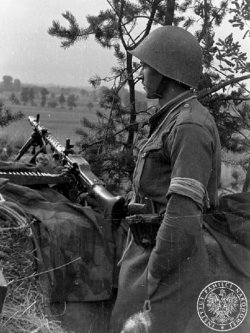
In a battle position near the village of Lawy. Rifleman "Sum" Jozef Jerzak at the MG-34 machine gun.
(archives of IPN, BU 1132, neg.3, kl.58, author: L. Gaszewski);
It is rather impossible to tell for certain which Pole brought the German aircraft down. In book "Powstanie Warszawskie" ["Warsaw Uprising"], Adam Borkiewicz states that it was 2nd Lt. "Chlebowicz" Andrzej Polonski's doing (3rd Squadron, 27th Regiment; he died on September 29th, 1944, in the area of Budy Zosine).
German intelligence report confirmed the loss of the plane and stated shortly: "7 km to the west of Grodzisk our aircraft was shot down by bandits."
Although we are not one-hundred-percent able to identify Polish soldiers of the insurgent army who shot down German aircrafts, it is worth noting that they were awarded in some way (source: Wielka Ilustrowana Encyklopedia Powstania Warszawskiego tom 4, Warszawa 1997 [Large Illustrated Encyclopaedia of the Warsaw Uprising, volume 4, Warsaw 1997):
- Ciszewski Jerzy "Motz" was awarded Class V of the Virtuti Militari upon the order no. 526 of the Home Army Commander of August 28th, 1944,
- Polonski Andrzej "Chlebowicz" was awarded Class V of the Virtuti Militari posthumously upon the order of October 1st, 1944.
According to Tomasz Zatwarnicki "Whatfor", the editor of website: www.powstanie-warszawskie-1944.pl, also Jan Korzybski "Irma" was awarded the silver cross of the Virtuti Militari posthumously, and the widow Maria Korzybska ("Isia") could receive the decoration from the Polish Home Army Association in London in September 1962.
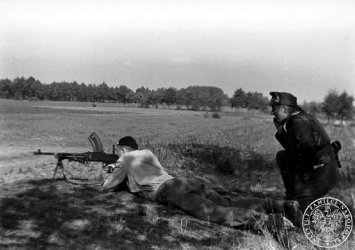
Another possible anti-aircraft weapon - a Bren MK II LMG of the airdrops of the Allied Forces
From the left: 2nd Lieutenant "Orlik" Tadeusz Nowicki and Corporal "Bohun" Czeslaw Stanczyk.
(archives of IPN, BU 1132, neg.4, kl.108, author: L. Gaszewski, Wiersze, around September 20th ,1944).
the author of "Puszcza Kampinoska - Jaktorow 1944",
which Bellona Publishing House
is planning to publish in 2011
edited by: Maciej Janaszek-Seydlitz
Bibliography:
1. Bączyk Norbert, Luftwaffe przeciwko powstaniu warszawskiemu, "Lotnictwo" 10/2009;
2. Borkiewicz Adam, Powstanie Warszawskie. 1944. Zarys działań natury wojskowej, Warszawa 1964;
3. Kirchmayer Jerzy, Powstanie Warszawskie. 1944, Warszawa 1984;
4. Koszada Józef "Harcerz", Grupa Kampinos. Partyzanckie zgrupowanie Armii Krajowej walczące w Powstaniu Warszawskim, Warszawa 2007
5. Kulesza Juliusz, Sierpień przez całe życie, Warszawa 1994;
6. Kulesza Juliusz, Powstańcza Starówka, Warszawa 2007;
7. Lenczewski Witold por. "Witold", "Strzała" i Hoppen-Zawadzka Jadwiga, Pięć lat na wojennych ścieżkac, Warszawa 1998;
8. Pilch Adolf, Partyzanci trzech puszcz, Warszawa1992;
9. Podgóreczny Marian "Żbik", Doliniacy. Nieznane dzieje Zgrupowania Stołpecko-Nalibockiego AK, tom 1-3, Gdańsk 1991/1993;
10. Podgóreczny Marian "Żbik", Na koniu i pod koniem, maszynopis;
11. Sawicki Tadeusz, Rozkaz: zdławić powstanie. Siły zbrojne III Rzeszy w walce z Powstaniem Warszawskim 1944, Warszawa 2001;;
12. Wielka Ilustrowana Encyklopedia Powstania Warszawskiego, tom 1, 4, 5, 6, Warszawa 1997-2005;;
13. Zatwarnicki Tomasz "Whatfor", strona internetowa http://www.powstanie-warszawskie-1944.pl/;
Attention! Larger part of the text can be found in the 2(29)/2011 issue of "Aero" magazine.
translation: Paweł Boruciak
Copyright © 2011 SPPW1944. All rights reserved.